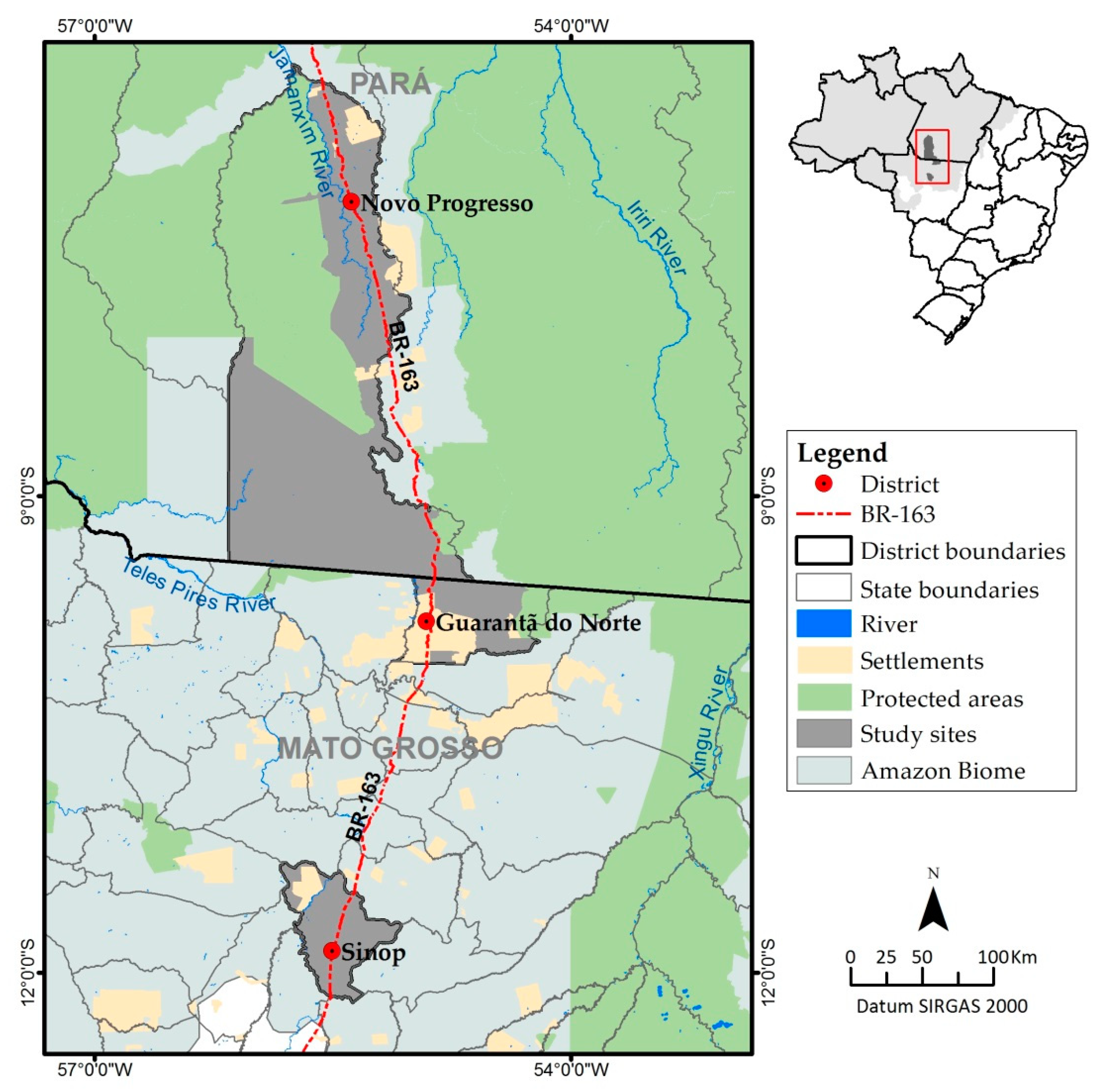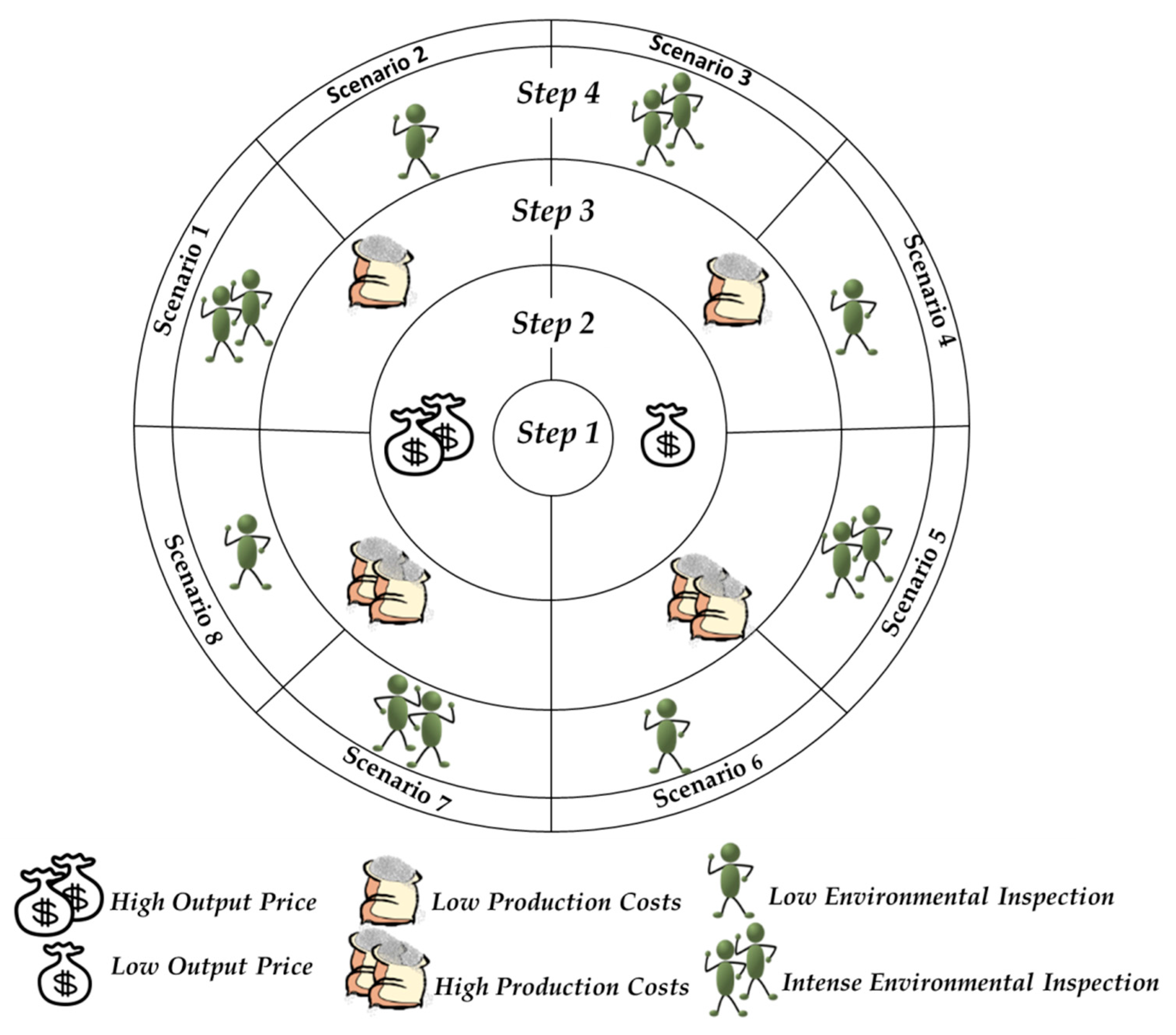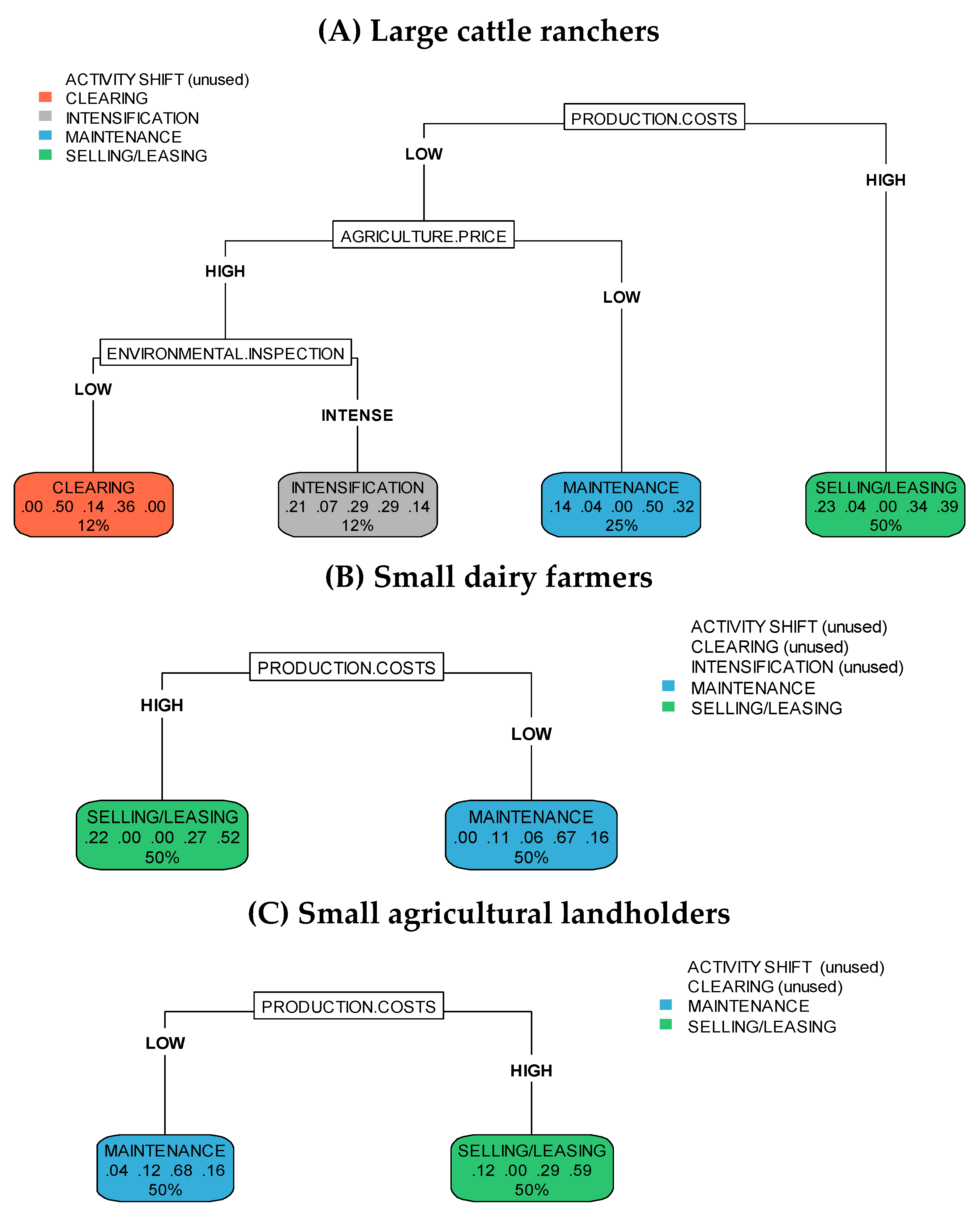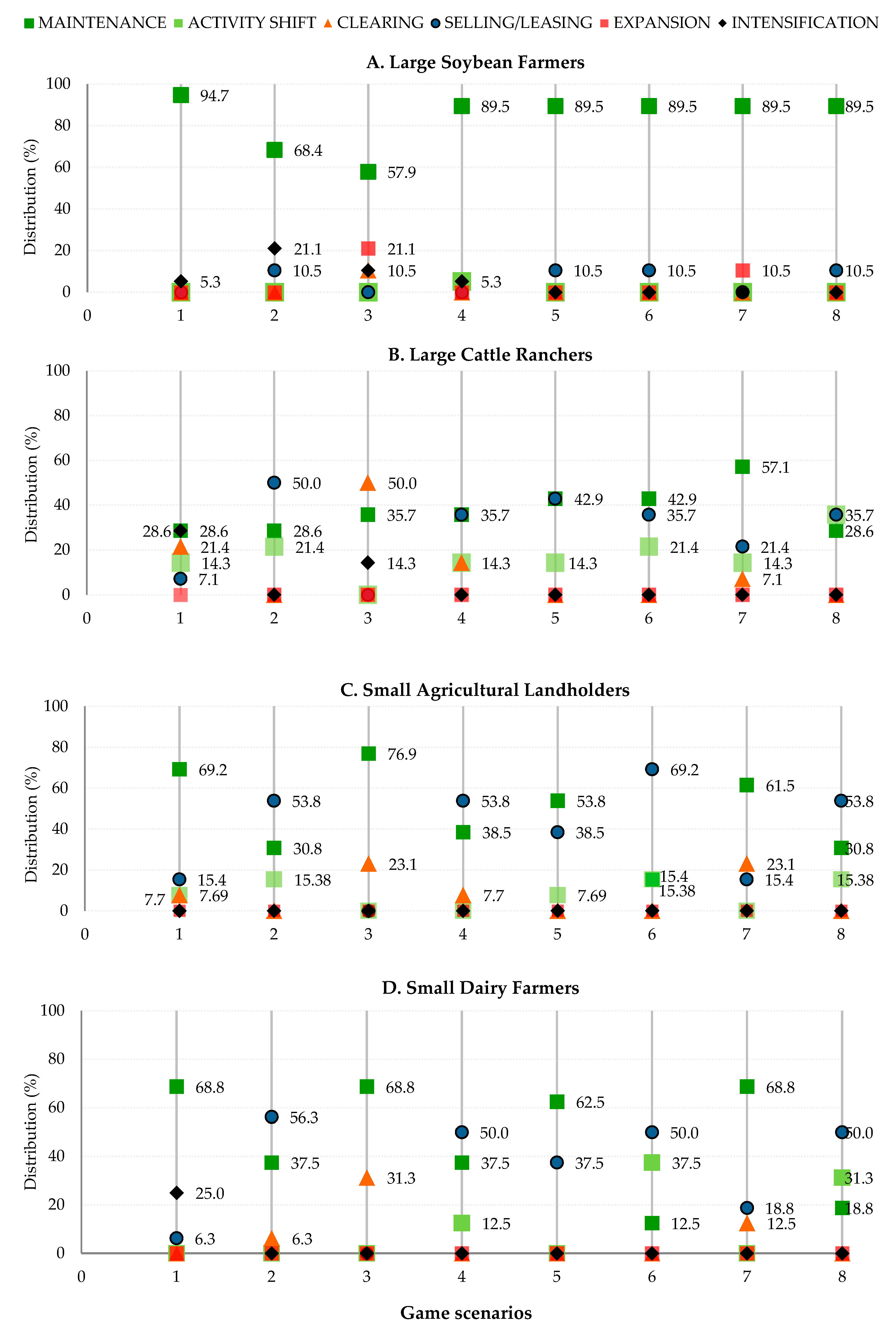What Drives Intensification of Land Use at Agricultural Frontiers in the Brazilian Amazon? Evidence from a Decision Game
Abstract
1. Introduction
2. Materials and Methods
2.1. Study Site
2.2. Questionnaire and Decision Game
2.2.1. Attributes and Levels
2.2.2. Focal Groups
2.2.3. Game Design and Application
2.2.4. Data Collection
2.3. Decision Analysis
3. Results
3.1. Land-Use Change Decision Trees
3.2. Dispersion Charts
3.3. Evidence from Questionnaires
4. Discussion
5. Conclusions
Supplementary Materials
Author Contributions
Funding
Acknowledgments
Conflicts of Interest
References
- United Nations, Department of Economic and Social Affairs, P.D. World Population Prospects: The 2017 Revision, Methodology of the United Nations Population Estimates and Projections; United Nations, Department of Economic and Social Affairs, P.D: New York, NY, USA, 2017. [Google Scholar]
- Charles, H.; Godfray, J.; Garnett, T. Food security and sustainable intensification. Philos. Trans. R. Soc. B Biol. Sci. 2014, 369, 20120273. [Google Scholar]
- Carrasco, L.R.; Webb, E.L.; Symes, W.S.; Koh, L.P.; Sodhi, N.S. Global economic trade-offs between wild nature and tropical agriculture. PLoS Biol. 2017, 15, e2001657. [Google Scholar] [CrossRef]
- Armenteras, D.; Espelta, J.M.; Rodríguez, N.; Retana, J. Deforestation dynamics and drivers in different forest types in Latin America: Three decades of studies (1980–2010). Glob. Environ. Chang. 2017, 46, 139–147. [Google Scholar] [CrossRef]
- Le Polain de Waroux, Y.; Baumann, M.; Gasparri, N.I.; Gavier-Pizarro, G.; Godar, J.; Kuemmerle, T.; Müller, R.; Vázquez, F.; Volante, J.N.; Meyfroidt, P. Rents, Actors, and the Expansion of Commodity Frontiers in the Gran Chaco. Ann. Am. Assoc. Geogr. 2018, 8, 290–298. [Google Scholar] [CrossRef]
- Gibbs, H.K.; Munger, J.; L’Roe, J.; Barreto, P.; Pereira, R.; Christie, M.; Amaral, T.; Walker, N.F. Did Ranchers and Slaughterhouses Respond to Zero-Deforestation Agreements in the Brazilian Amazon? Conserv. Lett. 2016, 9, 32–42. [Google Scholar] [CrossRef]
- Walker, R.; Moran, E.; Anselin, L. Deforestation and Cattle Ranching in the Brazilian Amazon: External Capital and Household Processes. World Dev. 2000, 28, 683–699. [Google Scholar] [CrossRef]
- Walker, R.; Homma, A.K.O. Land use and land cover dynamics in the Brazilian Amazon: an overview. Ecol. Econ. 1996, 18, 67–80. [Google Scholar] [CrossRef]
- Perz, S.G.; Walker, R.T. Household Life Cycles and Secondary Forest Cover Among Small Farm Colonists in the Amazon. World Dev. 2002, 30, 1009–1027. [Google Scholar] [CrossRef]
- Vosti, S.A.; Witcover, J. Slash-and-burn agriculture - Household perspectives. Agric. Ecosyst. Environ. 1996, 58, 23–38. [Google Scholar] [CrossRef]
- Brondízio, E.S.; Cak, A.; Caldas, M.M.; Mena, C.; Bilsborrow, R.; Futemma, C.T.; Ludewigs, T.; Moran, E.F.; Batistella, M. Small farmers and deforestation in Amazonia. In Amazônia and Global Change; Wiley Blackwell: Hoboken, NJ, USA, 2013; pp. 117–143. [Google Scholar]
- Becker, B.K. Modelos e cenários para a Amazônia: o papel da ciência Revisão das políticas de ocupação da Amazônia: é possível identificar modelos para projetar cenários? Parcer. Estratégicas 2001, 6, 135–159. [Google Scholar]
- Castro, E. Políticas de ordenamento territorial, desmatamento e dinâmicas de fronteira. Novos Cad. NAEA 2007, 10, 105–126. [Google Scholar] [CrossRef][Green Version]
- Fearnside, P.M. Brazil’s Cuiabá- Santarém (BR-163) Highway: The environmental cost of paving a soybean corridor through the Amazon. Environ. Manag. 2007, 39, 601. [Google Scholar] [CrossRef] [PubMed]
- Castro, R.B.; Albernaz, A.L. Consistency and use of information about threats in the participatory process for identification of priority conservation areas in the Brazilian Amazon. J. Nat. Conserv. 2016, 30, 44–51. [Google Scholar] [CrossRef]
- Coy, M.; Klingler, M. Frentes pioneiras em transformação: o eixo da BR-163 e os desafios socioambientais. Rev. Territ. Front. 2014, 7, 1–26. [Google Scholar] [CrossRef]
- IBGE - Instituto Brasileiro de Geografia e Estatística Produção Agrícola Municipal. Available online: https://sidra.ibge.gov.br (accessed on 9 September 2018).
- MDIC—Ministério da indústria comércio exterior e Serviços Balança Comercial. Available online: http://www.mdic.gov.br/ (accessed on 22 December 2018).
- Morton, D.C.; Noojipady, P.; Macedo, M.M.; Gibbs, H.; Victoria, D.C.; Bolfe, E.L. Reevaluating suitability estimates based on dynamics of cropland expansion in the Brazilian Amazon. Glob. Environ. Chang. 2016, 37, 92–101. [Google Scholar] [CrossRef]
- Gollnow, F.; Lakes, T. Policy change, land use, and agriculture: The case of soy production and cattle ranching in Brazil, 2001–2012. Appl. Geogr. 2014, 55, 203–211. [Google Scholar] [CrossRef]
- Macedo, M.N.; DeFries, R.S.; Morton, D.C.; Stickler, C.M.; Galford, G.L.; Shimabukuro, Y.E. Decoupling of deforestation and soy production in the southern Amazon during the late 2000s. Proc. Natl. Acad. Sci. 2012, 109, 1341–1346. [Google Scholar] [CrossRef] [PubMed]
- Gibbs, H.K.; Rausch, L.; Munger, J.; Schelly, I.; Morton, D.C.; Noojipady, P.; Soares-Filho, B.; Barreto, P.; Micol, L.; Walker, N.F. Brazil’s Soy Moratorium: Supply-chain governance is needed to avoid deforestation. Science (80-). 2015, 347, 377–378. [Google Scholar] [CrossRef]
- Fearnside, P. Deforestation of the Brazilian Amazon. Oxford Res. Encycl. Environ. Sci. 2017, 3–59. [Google Scholar]
- Kastens, J.H.; Brown, J.C.; Coutinho, A.C.; Bishop, C.R.; Esquerdo, J.C.D.M. Soy moratorium impacts on soybean and deforestation dynamics in Mato Grosso, Brazil. PLoS ONE 2017, 12, e0176168. [Google Scholar] [CrossRef] [PubMed]
- Dalla-Nora, E.L.; de Aguiar, A.P.D.; Lapola, D.M.; Woltjer, G. Why have land use change models for the Amazon failed to capture the amount of deforestation over the last decade? Land Use Policy 2014, 39, 403–411. [Google Scholar] [CrossRef]
- Arima, E.Y.; Richards, P.; Walker, R.; Caldas, M.M. Statistical confirmation of indirect land use change in the Brazilian Amazon. Environ. Res. Lett. 2011, 6, 024010. [Google Scholar] [CrossRef]
- Lima, M.; Antonio Da Silva Junior, C.; Rausch, L.; Gibbs, H.K.; Johann, J.A. Demystifying sustainable soy in Brazil. Land Use Policy 2018, 82, 349–352. [Google Scholar] [CrossRef]
- Silva, C.A.; Lima, M. Soy Moratorium in Mato Grosso: Deforestation undermines the agreement. Land Use Policy 2018, 71, 540–542. [Google Scholar] [CrossRef]
- Alix-Garcia, J.; Gibbs, H.K. Forest conservation effects of Brazil’s zero deforestation cattle agreements undermined by leakage. Glob. Environ. Chang. 2017, 47, 201–217. [Google Scholar] [CrossRef]
- Nepstad, D.; McGrath, D.; Stickler, C.; Alencar, A.; Azevedo, A.; Swette, B.; Bezerra, T.; DiGiano, M.; Shimada, J.; Da Motta, R.S.; et al. Slowing Amazon deforestation through public policy and interventions in beef and soy supply chains. Science (80-). 2014, 344, 1118–1123. [Google Scholar] [CrossRef] [PubMed]
- Sills, E.O.; Herrera, D.; Kirkpatrick, A.J.; Brandão, A.; Dickson, R.; Hall, S.; Pattanayak, S.; Shoch, D.; Vedoveto, M.; Young, L.; et al. Estimating the impacts of local policy innovation: The synthetic control method applied to tropical deforestation. PLoS ONE 2015, 10, e0132590. [Google Scholar] [CrossRef] [PubMed]
- Börner, J.; Kis-Katos, K.; Hargrave, J.; König, K. Post-crackdown effectiveness of field-based forest law enforcement in the Brazilian Amazon. PLoS ONE 2015, 10, e0121544. [Google Scholar] [CrossRef] [PubMed]
- Banerjee, O.; MacPherson, A.J.; Alavalapati, J. Toward a policy of sustainable forest management in Brazil: A historical analysis. J. Environ. Dev. 2009, 18, 130–153. [Google Scholar] [CrossRef]
- Freitas, F.L.M.; Sparovek, G.; Berndes, G.; Persson, U.M.; Englund, O.; Barretto, A.; Mörtberg, U. Potential increase of legal deforestation in Brazilian Amazon after Forest Act revision. Nat. Sustain. 2018, 1, 665–670. [Google Scholar] [CrossRef]
- Soares-Filho, B.; Rajão, R.; Macedo, M.; Carneiro, A.; Costa, W.; Coe, M.; Rodrigues, H.; Alencar, A. Cracking Brazil’s Forest Code. Science (80-). 2014, 344, 363–364. [Google Scholar] [CrossRef] [PubMed]
- Gollnow, F.; Hissa, L.D.B.V.; Rufin, P.; Lakes, T. Property-level direct and indirect deforestation for soybean production in the Amazon region of Mato Grosso, Brazil. Land Use Policy 2018, 78, 377–385. [Google Scholar] [CrossRef]
- Müller, H.; Rufin, P.; Griffiths, P.; de Barros Viana Hissa, L.; Hostert, P. Beyond deforestation: Differences in long-term regrowth dynamics across land use regimes in southern Amazonia. Remote Sens. Environ. 2016, 186, 652–662. [Google Scholar] [CrossRef]
- Baylis, K.; Honey-Rosés, J.; Börner, J.; Corbera, E.; Ezzine-de-Blas, D.; Ferraro, P.J.; Lapeyre, R.; Persson, U.M.; Pfaff, A.; Wunder, S. Mainstreaming Impact Evaluation in Nature Conservation. Conserv. Lett. 2016, 9, 58–64. [Google Scholar] [CrossRef]
- Moutinho, P.; Guerra, R.; Azevedo-Ramos, C. Achieving zero deforestation in the Brazilian Amazon: What is missing? Elem. Sci. Anthr. 2016, 4, 000125. [Google Scholar] [CrossRef]
- Le Tourneau, F.M. Is Brazil now in control of deforestation in the Amazon? CyberGeo Eur. J. Geogr. 2016. [Google Scholar] [CrossRef]
- Börner, J.; Baylis, K.; Corbera, E.; Ezzine-de-Blas, D.; Ferraro, P.J.; Honey-Rosés, J.; Lapeyre, R.; Persson, U.M.; Wunder, S. Emerging evidence on the effectiveness of tropical forest conservation. PLoS ONE 2016, 11, e0159152. [Google Scholar] [CrossRef] [PubMed]
- Edwards, W. The theory of decision making. Psychol. Bull. 1954, 51, 380. [Google Scholar] [CrossRef] [PubMed]
- Hansson, S.O. Decision Theory A Brief Introduction; Department of Philosophy and the History of Technology, Ed.; Royal Institute of Technology: Stockholm, Sweden, 1994. [Google Scholar]
- Singh, C.; Dorward, P.; Osbahr, H. Developing a holistic approach to the analysis of farmer decision-making: Implications for adaptation policy and practice in developing countries. Land Use Policy 2016, 59, 329–343. [Google Scholar] [CrossRef]
- Linkous, E.; Skuzinski, T. Land use decision-making in the wake of state property rights legislation: Examining the institutional response to Florida’s Harris Act. Land Use Policy 2018, 77, 603–612. [Google Scholar] [CrossRef]
- Celio, E.; Grêt-Regamey, A. Understanding farmers’ influence on land-use change using a participatory Bayesian network approach in a pre-Alpine region in Switzerland. J. Environ. Plan. Manag. 2016, 59, 2079–2101. [Google Scholar] [CrossRef]
- Lee, D. Game theory and neural basis of social decision making. Nat. Neurosci. 2008, 11, 404–409. [Google Scholar] [CrossRef] [PubMed]
- Ringland, G.; Schwartz, P.P. Scenario Planning: Managing for the Future; John Wiley & Sons, Inc.: Hoboken, NJ, USA, 1998; ISBN 047197790X. [Google Scholar]
- Fernández, A.J.C. Do cerrado à Amazônia: as estruturas sociais da economia da soja em Mato Grosso, Universidade do Rio Grande do Sul, 2007, Vol. Doutorado. Available online: https://lume.ufrgs.br/handle/10183/14276 (accessed on 3 May 2017).
- Oliveira, A.U. Oliveira BR-163 Cuiabá-Santarém: Geopolítica, grilagem, violência e mundialização. In Amazônia Revelada: os decaminhos ao longo da rodovia BR-163; CNPq: Brasília, Brazil, 2005; pp. 67–187. ISBN 8586821632. [Google Scholar]
- INPE PRODES—Monitoramento da Floresta Amazônica Brasileira por Satélite. Available online: http://www.obt.inpe.br/OBT/assuntos/programas/amazonia/prodes (accessed on 15 December 2018).
- INPE Monitoramento da floresta Amazônica Brasileira por satélite. Available online: http://www.obt.inpe.br (accessed on 15 October 2018).
- Therneau, T.M.; Atkinson, E.J.; Foundation, M. An Introduction to Recursive Partitioning Using the RPART Routines. Available online: https://cran.r-project.org/web/packages/rpart (accessed on 13 June 2018).
- Team R.C. A Language and Environment for Statistical Computing; R Foundation for Statistical Computing: Vienna, Austria, 2017. [Google Scholar]
- Therneau, T. A Short Introduction to Recursive Partitioning; Orion Technical Report 21.; Stanford University, Department of Statistics: Stanford, CA, USA, 1983. [Google Scholar]
- Pfaff, A.; Robalino, J.; Reis, E.J.; Walker, R.; Perz, S.; Laurance, W.; Bohrer, C.; Aldrich, S.; Arima, E.; Caldas, M.; et al. Roads & SDGs, tradeoffs and synergies: Learning from Brazil’s Amazon in distinguishing frontiers. Economics 2018, 12, 1–26. [Google Scholar]
- Soares Filho, B.; Nepstad, D.; Curran, L.M.; Cerqueira, G.C.; Garcia, R.A.; Ramos, C.A.; Voll, E.; McDonald, A.; Lefebvre, P.; Schlesinger, P. Modelling conservation in the Amazon basin. Nature 2006, 440, 520. [Google Scholar] [CrossRef]
- Cattaneo, A. Deforestation in the Brazilian Amazon: Comparing the Impacts of Macroeconomic Shocks, Land Tenure, and Technological Change. Land Econ. 2001, 77, 219–240. [Google Scholar] [CrossRef]
- Hargrave, J.; Kis-Katos, K. Economic Causes of Deforestation in the Brazilian Amazon: A Panel Data Analysis for the 2000s. Environ. Resour. Econ. 2013, 54, 471–494. [Google Scholar] [CrossRef]
- Schielein, J.; Börner, J. Recent transformations of land-use and land-cover dynamics across different deforestation frontiers in the Brazilian Amazon. Land Use Policy 2018, 76, 81–94. [Google Scholar] [CrossRef]
- Assunção, J.; Gandour, C.; Rocha, R. Deforestation Slowdown in the Brazilian Amazon: Prices or Policies? Environ. Dev. Econ. 2015, 20, 697–722. [Google Scholar] [CrossRef]
- Richards, P. It’s not just where you farm; It’s whether your neighbor does too. How agglomeration economies are shaping new agricultural landscapes. J. Econ. Geogr. 2018, 18, 84–110. [Google Scholar] [CrossRef]
- IBAMA - Instituto Brasileiro do Meio Ambiente e dos Recursos Naturis Renováveis. Available online: https://www.ibama.gov.br/relatorios (accessed on 12 June 2018).
- Barona, E.; Ramankutty, N.; Hyman, G.; Coomes, O.T. The role of pasture and soybean in deforestation of the Brazilian Amazon. Environ. Res. Lett. 2010, 5, 024002. [Google Scholar] [CrossRef]
- Richards, P.D.; Walker, R.T.; Arima, E.Y. Spatially complex land change: The indirect effect of Brazil’s agricultural sector on land use in Amazonia. Glob. Environ. Chang. 2014, 29, 1–9. [Google Scholar] [CrossRef] [PubMed]




| Site | Producer Group | Quantity Based on CAR ¹ | Drivers of Land Use Change |
|---|---|---|---|
| Sinop | Large soybean farmers | 25 | Sinop has relatively better infrastructure and is well connected to neighboring municipalities. It is considered a regional reference center for agricultural services and trade. Main land-use change drive is soybean, particularly involving the conversion of pastures to cropland [16,17,52]. |
| Large cattle ranchers | 15 | ||
| Small agricultural landholders | 946 | ||
| Small dairy farmers | 101 | ||
| Guarantã do Norte | Large soybean farmers | 4 | Guarantã do Norte is part of a milk-production belt in Mato Grosso. Main land-use change drives are soybean (much of it replacing old pastures) and cattle ranching [17,52]. |
| Large cattle ranchers | 25 | ||
| Small agricultural landholders | 64 | ||
| Small dairy farmers | 499 | ||
| Novo Progresso | Large soybean farmers | 3 | Cattle ranching is the main land use in Novo Progresso. Mining and logging, targeting international markets, have expanded recently and became important components of the local economy. Main land-use change drivers are soybean and cattle ranching, in addition to logging and gold mining [17,52]. |
| Large cattle ranchers | 163 | ||
| Small agricultural landholders | 206 | ||
| Small dairy farmers | 1210 |
| Scenario | Agricultural Prices | Production Costs | Environmental Inspection Intensity ¹ |
|---|---|---|---|
| 1 | High | Low | High |
| 2 | High | High | High |
| 3 | High | Low | Low |
| 4 | High | High | Low |
| 5 | Low | Low | High |
| 6 | Low | High | High |
| 7 | Low | Low | Low |
| 8 | Low | High | Low |
| Producers’ Groups | % of Total Interviewees | ||
|---|---|---|---|
| Sinop | Guarantã do Norte | Novo Progresso | |
| Large soybean producers | 21% | 5% | 25% |
| Large cattle ranchers | 11% | 5% | 55% |
| Small agriculturalists | 66% | 25% | 8% |
| Small dairy farmers | 2% | 65% | 12% |
| Farmers Group (Product) | Current Values ¹ (Brazilian Real) | High Values (Brazilian Real) | Low Values (Brazilian Real) |
|---|---|---|---|
| Large soybean producers (60 kg sack of soybeans) | 49 (46–60) | 75 (70–81) | 45 (40–55) |
| Small agricultural landholders (60 kg sack of soybeans) | 55 (50–55) | 75 (65–80) | 45 (43–48) |
| Cattle ranchers (15 kg of beef) | 110 (108–115) | 130 (130–160) | 100 (100–110) |
| Small dairy farmers (liter of milk) | 1.10 (100–120) | 1.30 (120–150) | 1.00 (100–110) |
© 2019 by the authors. Licensee MDPI, Basel, Switzerland. This article is an open access article distributed under the terms and conditions of the Creative Commons Attribution (CC BY) license (http://creativecommons.org/licenses/by/4.0/).
Share and Cite
Nascimento, N.; West, T.A.P.; Börner, J.; Ometto, J. What Drives Intensification of Land Use at Agricultural Frontiers in the Brazilian Amazon? Evidence from a Decision Game. Forests 2019, 10, 464. https://doi.org/10.3390/f10060464
Nascimento N, West TAP, Börner J, Ometto J. What Drives Intensification of Land Use at Agricultural Frontiers in the Brazilian Amazon? Evidence from a Decision Game. Forests. 2019; 10(6):464. https://doi.org/10.3390/f10060464
Chicago/Turabian StyleNascimento, Nathália, Thales A. P. West, Jan Börner, and Jean Ometto. 2019. "What Drives Intensification of Land Use at Agricultural Frontiers in the Brazilian Amazon? Evidence from a Decision Game" Forests 10, no. 6: 464. https://doi.org/10.3390/f10060464
APA StyleNascimento, N., West, T. A. P., Börner, J., & Ometto, J. (2019). What Drives Intensification of Land Use at Agricultural Frontiers in the Brazilian Amazon? Evidence from a Decision Game. Forests, 10(6), 464. https://doi.org/10.3390/f10060464





